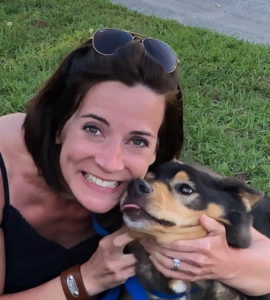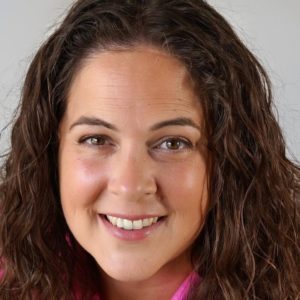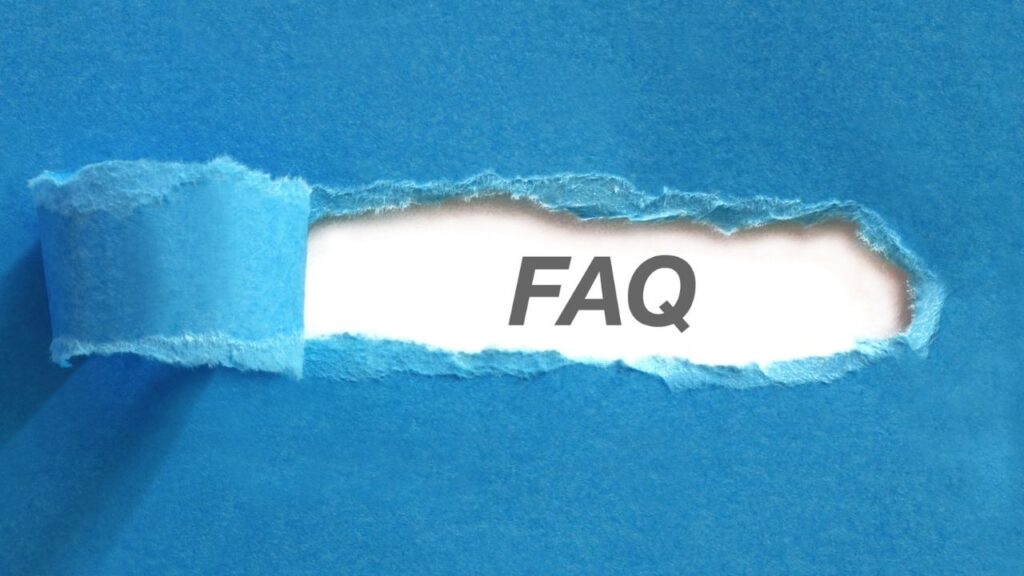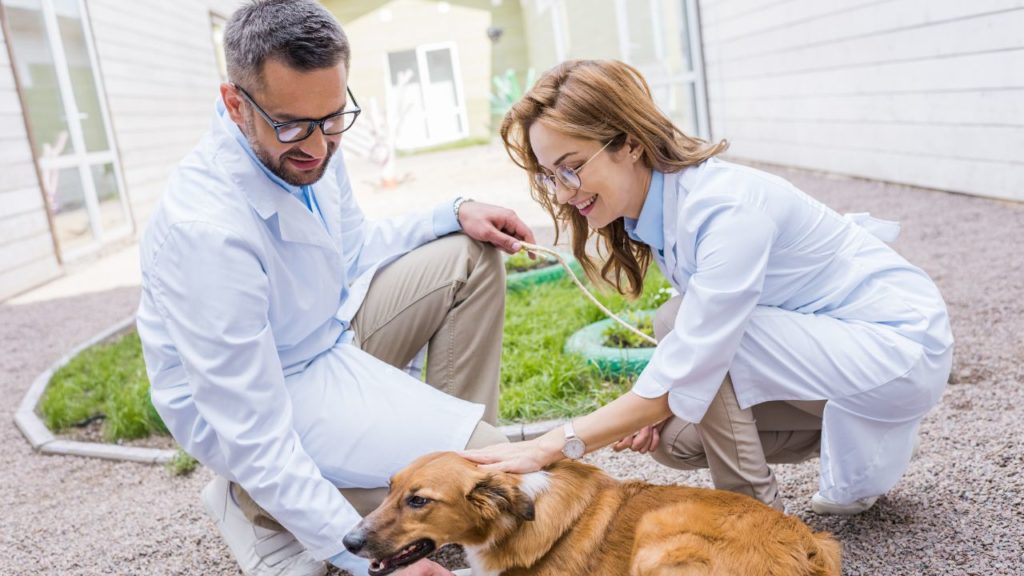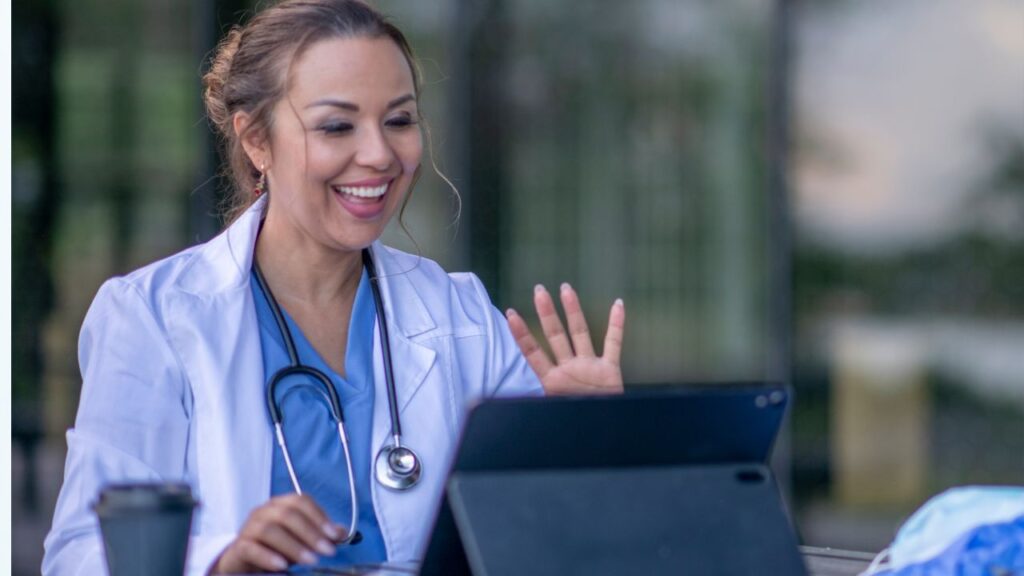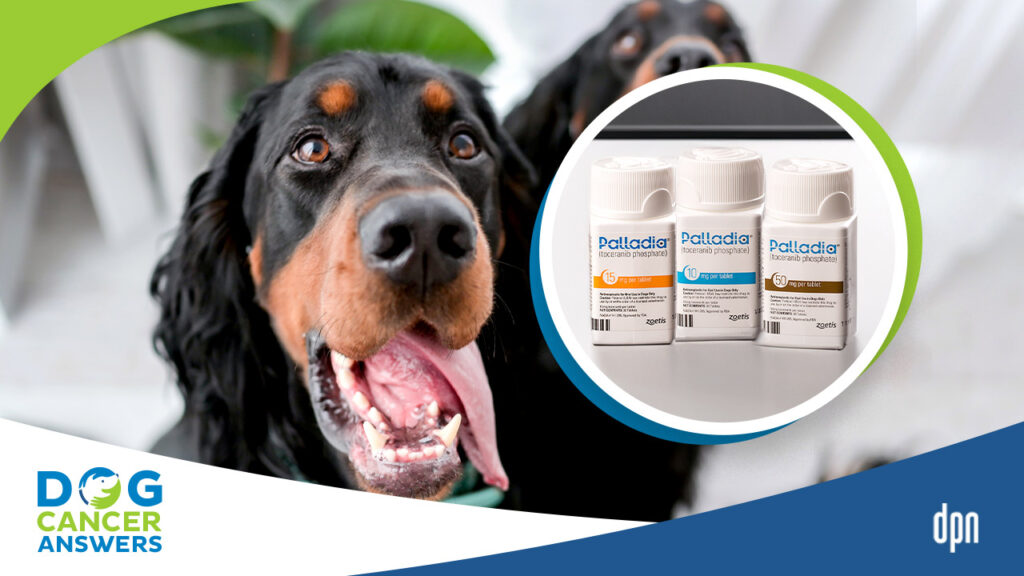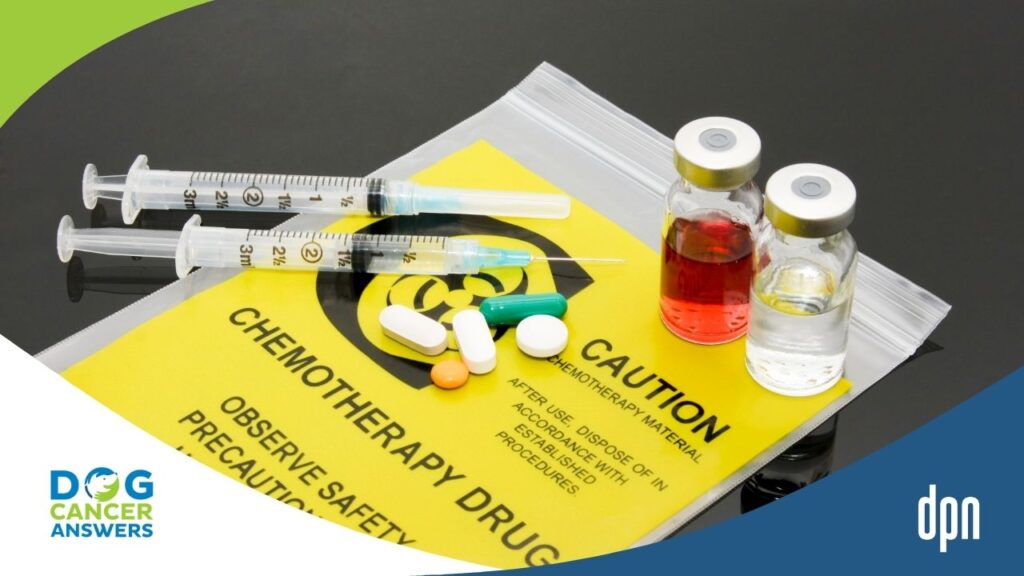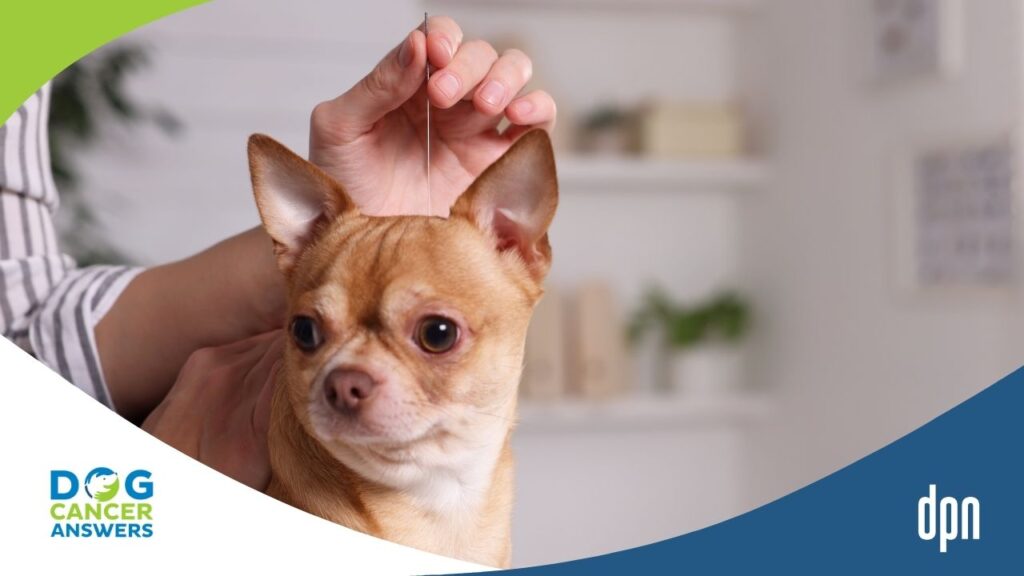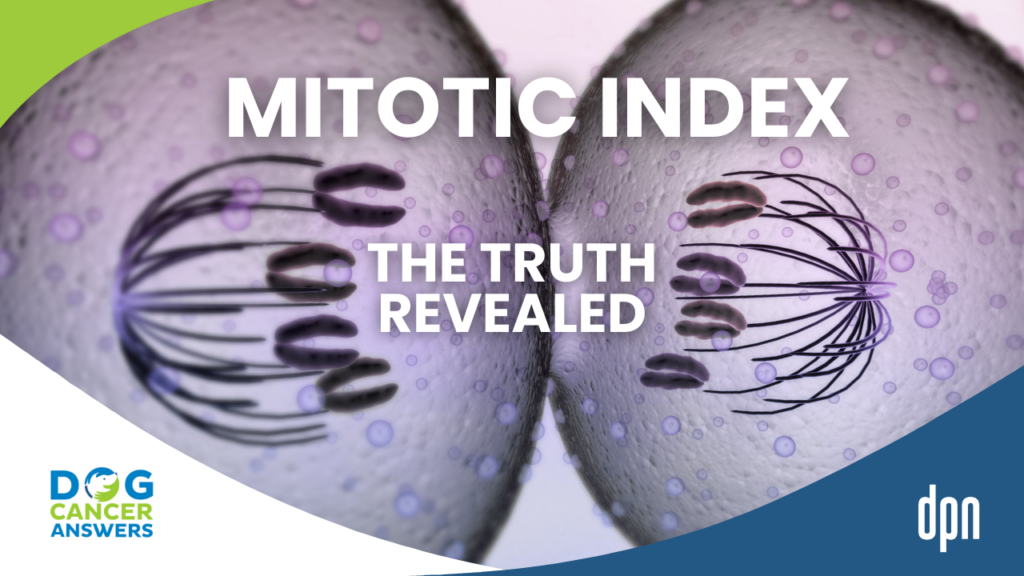EPISODE 222 | RELEASED June 26, 2023
Can Regular Vets Do Chemo for Dogs? Yes! | Dr. Kristen Lester
Your general practice vet may be able to do your dog’s chemotherapy! This can save travel time and money.
SHOW NOTES
Dr. Kristin Lester is a general practice veterinarian who also offers chemotherapy for her cancer patients. You heard right – any vet can do chemotherapy, not just oncologists. Not all “regular” vets offer chemo, but those that do have some special safety equipment and protocols to keep the clinic staff, you, and your dog all safe and healthy.
Complicated and unusual cases still absolutely benefit from seeing an oncologist, but straightforward cancer cases may be able to be handled at your local vet’s office. If an oncologist isn’t an option in your area, see if your vet or another local vet is able to do chemotherapy. Oncologists are usually happy to give advice to other vets remotely.
Dr. Lester also tells the story of her incredible dog Sue Louise, the tutu-wearing hunting dog who inspired her passion for chemotherapy.
Links Mentioned in Today’s Show:
USP 800 Guidelines: https://www.usp.org/compounding/general-chapter-hazardous-drugs-handling-healthcare
2016 AAHA Oncology Guidelines for Dogs and Cats: https://www.aaha.org/aaha-guidelines/oncology-configuration/oncology-guidelines/
Videos of closed system transfer devices: https://www.youtube.com/results?search_query=closed+system+transfer+device+for+chemo
Related Links:
Palladia for Dogs (toceranib phosphate) article
Pet Cancer Care Consulting: Dog Cancer Care Online podcast episode
Is Dog Chemotherapy Worth It? article
[00:00:00] >> Dr. Kristen Lester: They’re gonna know your pet, you know, they’re gonna have that warm personal touch because they’ve been seeing your pet for quite a while. And they know maybe a little bit about what you like to do on the weekends, or they may know, you know, what is the funny things that your dog does, or that he ate a foreign body last year, and that was dramatic.
[00:00:22] >> Announcer: Welcome to Dog Cancer Answers where we help you help your dog with cancer.
[00:00:28] >> Molly Jacobson: Hello, friend. I’m Molly Jacobson, and today on Dog Cancer Answers, we’re talking about chemotherapy. Many dogs with cancer end up getting chemotherapy from an oncologist, but your general practice vet might also offer it. Doing chemotherapy does require special equipment and safety measures, so it isn’t for the faint of heart, but some brave vets add it to their long list of services.
Joining us today is one of those brave vets, Dr. Kristen Lester. Dr. Lester is a member of our editorial team for dogcancer.com, she’s a veterinarian with a special interest in oncology.
Dr. Lester, thank you so much for coming on the show.
[00:01:08] >> Dr. Kristen Lester: Absolutely. I’m so happy to be here. Thank you, Molly.
[00:01:11] >> Molly Jacobson: Absolutely. We are so pleased to talk to you today because you have very specific experience that I think the lay people listening to our podcast and the veterinarians who tune in to our podcast will be interested in. You are a general practice vet with a special interest in oncology who actually does chemotherapy in your general practice. So tell me a little bit about how that happened, how you got into that.
[00:01:42] >> Dr. Kristen Lester: Well, so it was very organic. I graduated about 17 years ago and you know, one of the things that was really, um, impressive about going through veterinary school at that time, I specifically remember my oncology block and, you know, going in and just talking with the specialists there and you know, something that’s so sad like cancer and just, it can be very, very hard and, and difficult.
Their attitudes about it were so positive and celebratory and you know, not a day went by where we didn’t give a certificate or, you know, high fives because a pet ended up achieving something, whether it was remission or their final chemo or, you know, just did really, really well with their treatments. And so I left that block with this positivity about it and, you know, came away with such a, a good experience.
[00:02:41] >> Molly Jacobson: Where did you go to school?
[00:02:43] >> Dr. Kristen Lester: I went to Louisiana State University.
[00:02:45] >> Molly Jacobson: Right.
[00:02:45] >> Dr. Kristen Lester: Which is where I’m from originally. So yeah, it was just a good experience with that block. So then I graduated and for the first three or four years of my career, I don’t really remember doing a whole lot of oncology or chemotherapy. At that point, I was just discovering what it was like to be a new veterinarian and you know, learning how to spay a dog in less than an hour, you know, or, you know, to not panic every time I did anesthesia and just all the things that new grads go through.
I remember my first allergic reaction and I was like, oh, you know, just, just learning, just being so young. But, you know, eventually that time passed, thankfully, and about four years in there was my heart dog that came into my life. I can share a little bit about Sue. She was a, um, I call her the stinky hunting dog. She, she really was. At, at that point in my career, I was practicing in a rural town in South Carolina, and so we saw a lot of hunting dogs.
And she was 13 and her, yeah, and her actual owner – I was her later in life owner – her actual owner passed away. He was an elderly man. And when- I know, I know. And when he passed, he left behind six animals to all of his kids and I think they were overwhelmed and, and didn’t know what to do.
And they saw Sue was 13, so they scheduled an appointment to euthanize her. So Sue came in to my practice for that last appointment, and one of my colleagues looked at her and just thought, she still has some life. Look at this scrappy old girl. And so he asked them if he could find her a home.
[00:04:53] >> Molly Jacobson: Aww.
[00:04:54] >> Dr. Kristen Lester: And so they were very appreciative and they signed her over and, and we took her on and, and I saw her in the cage and it was love at first sight. So that stinky hunting dog got to come home and, and live with me. And I don’t know if she, you know, lived indoors or outside at that, that point. She didn’t act like it, but I made her an indoor dog and we painted her toenails and I got her a tutu, and she became a very fancy hunting dog.
[00:05:23] >> Molly Jacobson: A very fancy hunting dog.
[00:05:25] >> Dr. Kristen Lester: She’s a very fancy hunting dog. So I loved everything about her. She’s just, just funny. So getting back to my cancer journey and, and treating cancer, about four months in, she had a lump on her right rear thigh, and here’s my little, um, high horse about it: that lump was soft and it was squishy and freely movable. So what I’m trying to say is that it felt like a lipoma, and when I found it at home, I was like, oh, this is probably a lipoma.
[00:06:00] >> Molly Jacobson: Uh huh.
[00:06:01] >> Dr. Kristen Lester: But as, as any, um, good general practitioner should do, I aspirated it and immediately I found out that it was a mast cell tumor.
[00:06:10] >> Molly Jacobson: Ah, the great pretender that can look like anything it wants to.
[00:06:13] >> Dr. Kristen Lester: It looked just like a juicy lipoma. So luckily my boss at the time – ’cause I didn’t wanna operate on my own dog – he said, we can remove this today, and took great margins. And we had it biopsied and it came back as a high grade grade two mast cell tumor. And yeah, I know, it was a bummer. And then at the bottom, I remember the report said these types of tumors have a mean survival time of about four to five months, which to me wasn’t what I wanted to hear. I wanted more. I just got her. She’s great.
[00:06:52] >> Molly Jacobson: Right. Right.
[00:06:54] >> Dr. Kristen Lester: She had a tutu.
[00:06:56] >> Molly Jacobson: Her nails were barely dry.
[00:06:58] >> Dr. Kristen Lester: Her nails were barely dry. So I needed more time. And so, once again, I’m very young in my career and I just remembered this positive experience. We did have a specialty hospital about 40 minutes away, so this was Charleston, South Carolina, so I could have had that resource, but that spark was already there and I felt like this is something that I can do. And so I started chemo with Sue. This was my first IV chemo patient.
We did vinblastine every week for four weeks, then every other week for four treatments. That girl had no white blood cell abnormalities. Her blood work was perfect the entire time. She had no side effects. She did amazing.
[00:07:47] >> Molly Jacobson: That’s amazing.
[00:07:48] >> Dr. Kristen Lester: Yeah. Yeah. And so I felt really good about that. Well then months later, then all of a sudden her popliteal lymph node was palpable. And then I did an abdominal-
[00:07:59] >> Molly Jacobson: And that’s behind the knee?
[00:08:00] >> Dr. Kristen Lester: That’s right behind the knee. So her tumor was on her thigh, and so the popliteal in that same leg got big and juicy. So it was metastasizing at that point. And I did an abdominal ultrasound and there were her sublumbar lymph nodes, which are these lymph nodes that live right at the bifurcation or the splitting of the aorta.
[00:08:24] >> Molly Jacobson: Oh.
[00:08:24] >> Dr. Kristen Lester: Um, the aorta being the major, major artery of the body.
[00:08:28] >> Molly Jacobson: Yeah.
[00:08:29] >> Dr. Kristen Lester: And having lymph nodes there, you know, I didn’t feel gutsy to remove those. And so, you know, at that point, oh, at that point.
[00:08:37] >> Molly Jacobson: Because they’re just so, they’re so close to the aorta, removing them would be really, really dangerous it sounds like.
[00:08:44] >> Dr. Kristen Lester: Yeah. It can be done for sure. And I’ve seen it done, I’ve seen surgeons do it, but it wasn’t a choice I wanted to make for Sue. And so my thought process is, well, what do we do now? At that time, this was around 2012-13, and a drug, wonderful drug called Palladia is coming into the picture. It was labeled for nonresectable mast cell tumors. And we started at that point, I think we were talking about KIT mutations and you know, all of those things that are more common language now, but back then it wasn’t really discussed, especially amongst the general practitioner community. I contacted an oncologist from the area and, and she really was wonderful and we said, oh, should we do Palladia, or there’s another drug, Kinavet, and we’re going back and forth. And she was like, I think you should do Palladia. So I said done. So I ordered Palladia and once again we started it, those lymph nodes shrink, and she just kept trucking along. So.
[00:09:53] >> Molly Jacobson: This whole time she’s fine. It sounds like.
[00:09:56] >> Dr. Kristen Lester: She’s fine.
[00:09:56] >> Molly Jacobson: Right.
[00:09:57] >> Dr. Kristen Lester: I will say this, if anybody has ever, um, used Palladia before, or maybe they’re interested in using Palladia, one of the side effects that I saw when I started it, that first week she had incredible leg pain. And I think that was just part of the mast cell tumor, you know, being affected by this new drug. So much so for that first week, I was like, Ooh, is this something that I feel like I can continue? Consulted with the oncologist that was so friendly and generous in helping me a lot out along the way.
And she was like, okay, we’re gonna take a vacation, a little break, and then start back and she should be fine. And she never looked back. She did great. So we continued the protocol and that girl lived another couple of years, so.
[00:10:48] >> Molly Jacobson: Oh my goodness.
[00:10:49] >> Dr. Kristen Lester: I know, she did great. About six months prior to her passing at the age of 16, she did have an arrhythmia that was so bad that she needed a pacemaker, so.
[00:11:01] >> Molly Jacobson: Oh my goodness.
[00:11:03] >> Dr. Kristen Lester: So we brought- I know. Nobody in, and nobody in South Carolina did pacemakers. I contacted everybody in Charleston, Greenville, all the bigger cities. There’s not a vet school in, in South Carolina. So I contacted University of Georgia and NC State. NC State said, Can you come today? And I said, yep. So me and Sue and my husband Chris drove on up to NC State and they put in a pacemaker and, and once again, she didn’t look back. So.
[00:11:33] >> Molly Jacobson: That is crazy.
[00:11:35] >> Dr. Kristen Lester: Yeah.
[00:11:35] >> Molly Jacobson: That is- she was so strong.
[00:11:38] >> Dr. Kristen Lester: She was so strong and scrappy. So I always say she’s my heart dog just because she started my love for fighting cancer. And because she was so strong and she did so well with very, very few challenges, I felt like this is something I wanna build upon. So that’s how it all began. Yeah.
[00:12:01] >> Molly Jacobson: What an amazing story. I know there’s a lot of people listening who will be thinking a lot about what the possibilities are, especially those with mast cell tumors. But really any cancer diagnosis you really don’t know ahead of time. I mean, a 13 year old dog, most people would do exactly what Sue’s former dad’s kids did and sort of say, well, she probably doesn’t have that much time left, so why should we put a lot of effort into this. Let’s let things take their course, or make that choice that they made.
All of these are valid choices, but if you’re the person who’s wondering if she’s got something extra, if she’s got that little extra bit, give her a chance. If you can do it.
[00:12:43] >> Dr. Kristen Lester: Absolutely.
[00:12:43] >> Molly Jacobson: Yeah.
[00:12:43] >> Dr. Kristen Lester: No regrets. We had no regrets about any of it. Even with the pacemaker, we were at the point where it was, okay, she either has to be euthanized today, because she can’t live like this, her heart is gonna stop, or we have to take this risk with her. And um, you know, of course, it’s expensive. My husband and I were looking at each other, like, you know.
[00:13:07] >> Molly Jacobson: Right.
[00:13:08] >> Dr. Kristen Lester: Trying to like.
[00:13:09] >> Molly Jacobson: Yeah.
[00:13:09] >> Dr. Kristen Lester: Are we doing this? And we leapt, and we had, you know, no regrets. So, and I know, you know, it doesn’t always turn out-
[00:13:16] >> Molly Jacobson: Nope.
[00:13:17] >> Dr. Kristen Lester: -as a perfect story for everybody. So I don’t wanna, you know, paint this like rosy, rosy picture. But it was the right decision for her and, and I’m so thankful that she did so well and you know, how much she inspired me to continue and do more. So, yeah.
[00:13:32] >> Molly Jacobson: Well, thank you. So you started doing chemo with your heart dog, Sue.
[00:13:37] >> Dr. Kristen Lester: Yes.
[00:13:37] >> Molly Jacobson: And then you continued?
[00:13:39] >> Dr. Kristen Lester: Yes. So then right after Sue, we had this three-legged cat named Tucker. He didn’t have cancer, but he had a disease called cholangiohepatitis, which is a liver and gallbladder problem where his immune system was attacking his liver and gallbladder.
[00:13:58] >> Molly Jacobson: Oh, that sounds very bad.
[00:13:59] >> Dr. Kristen Lester: Yeah, yeah. I mean, it is.
[00:14:01] >> Molly Jacobson: Yeah.
[00:14:02] >> Dr. Kristen Lester: It is. It’s not good, but it can be managed. I consulted with an internal medicine specialist and that specialist gave him one year to live. And we started chlorambucil, which is a chemotherapeutic drug, it’s an oral drug, and we gave that as prescribed. And Tucker lived five years with minimal side effects.
Um, you know, his blood work – other than his liver enzymes being terrible ’cause he had this disease – they never had any consequences from the oral chemo. He never got immunosuppressed. So he too was a rockstar that beat all odds. So that only, not only with Sue, but then Tucker, just reinforced. So at that point it was like, I don’t wanna say it was like a drug, but it kind of was.
I just wanted to learn more and more and more. And so I was just investing a lot of time and continuing education and you know, any kind of certification that I could get, I was, I was doing it. So.
[00:15:08] >> Molly Jacobson: In oncology?
[00:15:09] >> Dr. Kristen Lester: In oncology, yes.
[00:15:10] >> Molly Jacobson: Uh huh.
[00:15:10] >> Dr. Kristen Lester: It was definitely my favorite area. So.
[00:15:13] >> Molly Jacobson: Did you ever consider getting board certified, becoming an oncologist?
[00:15:18] >> Dr. Kristen Lester: Yes and no. So kind of going back to my vet school career, I graduated at the young age of 26 and – it sounds so young now, but, I know.
[00:15:29] >> Molly Jacobson: I’m with you.
[00:15:30] >> Dr. Kristen Lester: Yeah.
[00:15:30] >> Molly Jacobson: Yeah.
[00:15:31] >> Dr. Kristen Lester: Just the young age of 26. And at that time, if you think about, I had been in school for 21 years if you count kindergarten on up.
[00:15:40] >> Molly Jacobson: Right.
[00:15:41] >> Dr. Kristen Lester: And you know, debt with student loans, and I was ready to make a living for myself. I was ready to hustle, if you will, and just wanted to get out in the workforce. And so I didn’t have any thoughts at the time that I wanted to do an internship or residency because it’s four more years of, I probably would’ve continued those loans and they, you know, they work so hard and you know, the pay is, um, it’s, you know, it’s just a very, very modest income for those interns and residents because they’re still getting their education. And that wasn’t the right decision for me.
So I went out into the workforce. But there’s been times since then where, you know, I, I just love oncology so much, and if I’m, um, you know, hands deep in a full mouth extraction, removing cat teeth, I’m thinking to myself, wow, I sure do wish I was an oncologist right now. But that’s okay. I mean, I like the variety of general practice, so, um, no regrets. I love oncologists and you know, I love having them as a resource, but I think I’m right where I’m supposed to be.
[00:16:54] >> Molly Jacobson: Well, that brings me to something I wanted to talk to you about because I know a lot of, uh, I’m going to get the exact number incorrect, so let’s say there are over 400 oncologists, not all of those are small animal oncologists, in the United States. And so there’s something like 60,000 general practitioner vets.
So there’s many, many more general practitioners than there are oncology specialists. And so, especially in the last few years when the veterinary industry has been undergoing so much change and that affects the ability to give care. I know that at one point last year at least there was a six month average wait to see an oncologist. And six months to wait to see your veterinary oncologist might not be enough time.
[00:17:44] >> Dr. Kristen Lester: No. And, and some of these pets only have six weeks.
[00:17:48] >> Molly Jacobson: Right.
[00:17:48] >> Dr. Kristen Lester: You know, our lymphoma dogs. That’s, it’s unacceptable and I feel so bad for the industry because, you know, they truly are doing the best they can, but there’s-
[00:17:56] >> Molly Jacobson: Of course.
[00:17:57] >> Dr. Kristen Lester: There’s way more animals that have cancer than oncologists can handle. So that’s where I think it is important for general practitioners to be empowered to do as much as they can. I think it is just really hard if, you know, that’s the only option if an animal gets diagnosed with cancer to say, well, there’s a six month wait with an oncologist, or I’m comfortable dispensing prednisone. There has to be a middle ground where there’s things that we can do in the intermediary in order to still fight cancer. And, and I think that we can do it well.
[00:18:35] >> Molly Jacobson: Right. And you have gotten that feedback from oncologists, correct, that – do they resent, is there a professional resentment that you are taking clients away from them as a general practitioner?
[00:18:47] >> Dr. Kristen Lester: I don’t think so. I’m sure that there may be a few that may think to themselves, well maybe y’all should stay in your lane, or, but I have not gotten that. I’ve gotten nothing but positive feedback. One of the things that I think it’s very important that I communicate to my clients is that I tell them, I am not a board certified oncologist.
If you want an oncologist, we’re gonna make that happen. We’re gonna refer you. Especially now I’m living in a, um, you know, a bigger city than previous places, I do offer that. But I’ll also say, on the other hand, I am very comfortable with doing chemotherapy. Here is my background. Here’s my experience. Here’s why I love to fight cancer. So this is an alternative if you do not wanna go that route.
So I feel like anytime I’ve talked to an oncologist, they’ve been very, very helpful and they haven’t been discouraging or you know, frustrated and, and I definitely don’t feel like they think we’re stealing their business. I think they are probably, I would hope, appreciative if we can take those basic boring, not boring, they’re not boring to me, but you know, maybe the ones that are a little more straightforward, like a CHOP protocol or-
[00:20:03] >> Molly Jacobson: For lymphoma?
[00:20:05] >> Dr. Kristen Lester: For lymphoma.
[00:20:06] >> Molly Jacobson: Yeah.
[00:20:06] >> Dr. Kristen Lester: Or just carboplatin for osteosarcoma. Or just things that are pretty routine or standard or simplistic and just save those big guns, those hard cases, save the ones that really, you know, make you scratch your head or using drugs that have more side effects, more complications, or just maybe a different perspective.
So I would like to hope that they are comfortable with general practitioners doing so as long as they are doing it the right way. And that’s what’s so important. We have to be doing it to the level that they are doing it, otherwise we shouldn’t be doing it at all. So.
[00:20:48] >> Molly Jacobson: Right. So what are the things that you do in your practice to give chemotherapy to patients that a general practitioner listening or a dog lover listening would want to look for in their general practice to make sure that this is safe for everybody. ‘Cause it’s not just the dog or the cat, it’s you as a practitioner, right? Like you want the humans to be safe in the practice.
[00:21:12] >> Dr. Kristen Lester: Absolutely. I mean, you put the nail on the head. Safety is the most important thing. Not only for dog safety – chemotherapeutic drugs have such a narrow margin of safety that you have to get that math correct. You know, for certain drugs like gabapentin or, which is, we use it for pain and anxiety and sedation in dogs and cats, or you know, an antibiotic or even a pain medication like Galliprant, or Cytopoint, these are all drugs where, you know, we may give the same dose to an animal that’s 10 pounds as we do an animal that’s 19 pounds or 20 pounds.
So there’s this huge margin of safety there in a lot of these drugs where we have a range. Chemo has to be exact. You can’t just round up or willy-nilly or just approximate 1 cc for 10 pounds or, you know, you can’t do that. It has to be done correctly. So one of the ways that I like to be as safe as possible from that aspect is I like a double check system.
I like for my technicians to be trained to also do the math, and then I like for both of us to calculate the math and say this is the dose that we are going to use. And we have to match. And if we don’t match, then we recalculate. And so by double check system, then I feel like that’s one way that we can be as safe as possible.
[00:22:42] >> Molly Jacobson: Where do you get those numbers from? Where do you get the numbers to calculate?
[00:22:46] >> Dr. Kristen Lester: Yeah. Yeah. So as far as the published doses, there’s a lot of resources available. My doses came from just my previous experience through LSU, they gave us an oncology drug guide handbook, and you know, a lot of those haven’t changed. Drug handbooks, literature, you know, there’s just various resources.
[00:23:07] >> Molly Jacobson: So these are all things that a GP can look up and find those published doses.
[00:23:12] >> Dr. Kristen Lester: Absolutely.
[00:23:13] >> Molly Jacobson: Okay.
[00:23:13] >> Dr. Kristen Lester: Absolutely. The more experienced with chemotherapy, you’ll kind of see that, okay, this is really the, this is the, the drug dose, and there may be a slight variation, but there’s not gonna be a huge change in the doses that are given. And so with that, we instead, so we both calculate. That’s the way that we keep the dogs safe. And then the way that we keep people safe is by using safety measures such as PPE, personal protective equipment. And I like to think of that as just like the safety bubble, this, uh, like a, a shield of armor, if you will.
Or, you know, just making sure that every entry point of the body, like the eyes and the mouth and the nose, are all protected by this equipment. You know, a face mask, and a respirator mask, and then a chemo gown, and double gloves or chemo gloves. So just that, that shield of armor, you know, that needs to be worn by every single person.
[00:24:15] >> Molly Jacobson: Because these compounds are, I mean, they’re very potent and effective, but you, if you’re healthy, don’t want them on your skin. Certainly don’t wanna ingest them.
[00:24:25] >> Dr. Kristen Lester: Yes.
[00:24:26] >> Molly Jacobson: Right.
[00:24:26] >> Dr. Kristen Lester: Highly frowned upon.
[00:24:27] >> Molly Jacobson: Because it does go through.
[00:24:29] >> Dr. Kristen Lester: It does go through. It’s frowned upon.
[00:24:31] >> Molly Jacobson: Highly frowned upon.
[00:24:32] >> Dr. Kristen Lester: Don’t bring your McDonald’s into the chemo room. Don’t set it on the counter. Don’t just spray it willy-nilly. Bad things can happen because they are considered hazardous drugs. They’re dangerous. If you are exposed to them chronically in an unsafe way, there’s a study, and I don’t remember exactly the resource, but they measured healthcare workers who are chronically giving chemo over long periods of time. Maybe they weren’t wearing the safety equipment, I don’t know, I don’t know the specifics, but they were actually measuring chemo in their urine.
[00:25:09] >> Molly Jacobson: Oh. Yeah.
[00:25:10] >> Dr. Kristen Lester: Yeah, yeah. And so what we know is that they can cause problems with unborn babies. They can cause cancer. It’s hard to believe that, you know, chemotherapy can cause mutations and that can lead to cancer. And so it is so important that we are safe because I don’t want to have cancer later on and wonder, was it because I was unsafe, I was lackadaisical and I didn’t care?
Or I would even be more devastated if one of my teammates got cancer and I put them in harm’s way because I was just like, oh, it’s just a quick injection, or this is no big deal, we can’t see this happening in your body, so it it’ll be fine. Well, I would feel terrible if they got cancer because of something that I didn’t do to protect them.
So it is of utmost importance that if a general practitioner is doing this, they have got to make sure that they are safe and they have to make sure that their team is safe. And if they don’t do – and the dog, by doing correct math and double checking.
[00:26:21] >> Molly Jacobson: Uh huh.
[00:26:22] >> Dr. Kristen Lester: They’ve gotta do those things, otherwise they shouldn’t be doing them [chemo], in my humble opinion.
[00:26:27] >> Molly Jacobson: Certainly sounds like there’s many good reasons for that. Is there special equipment that you need to administer chemo that – or can a general practice, once they get the personal protective equipment, can they just start doing it or is there anything that they’d need to do in their practice to start offering chemo?
[00:26:44] >> Dr. Kristen Lester: Yeah, absolutely. The more, the better, the safer you can be. And so a biosafety cabinet is absolutely preferred. Which I think in a way, it sounds like it’s so unattainable, but at our last practice, we were actually in the process of doing a new construction so we put in a biosafety cabinet. It was less than $10,000, which that’s a lot of money for sure. But it’s doable if you are going to not only make sure your staff is safe, that you’re safe, it’s so worth it, and it pays for itself.
So it’s a very, very doable thing. So I definitely recommend that that be, you know, an investment, especially if you’re gonna be doing a lot of chemo.
[00:27:31] >> Molly Jacobson: Tell me what that is.
[00:27:33] >> Dr. Kristen Lester: It’s like a, it’s called a hood. You know, you hear it, it being a hood.
[00:27:37] >> Molly Jacobson: Okay.
[00:27:37] >> Dr. Kristen Lester: And so you draw up chemo underneath the hood and it sucks all of the bad stuff up and out the building, so.
[00:27:46] >> Molly Jacobson: Oh, okay. So it just like, it’s a giant exhaust system basically.
[00:27:50] >> Dr. Kristen Lester: Exactly.
[00:27:51] >> Molly Jacobson: So it’s not floating around in the air-
[00:27:53] >> Dr. Kristen Lester: Yeah.
[00:27:54] >> Molly Jacobson: -while you prepare the chemo for a treatment.
[00:27:57] >> Dr. Kristen Lester: You’re trying to prevent aerosols from forming, and so it just goes up and out, out of sight.
[00:28:03] >> Molly Jacobson: Okay. Alright.
[00:28:05] >> Dr. Kristen Lester: So it’s, it’s a doable thing. It doesn’t sound attainable ’cause that’s not something, you don’t go in every single vet practice and Oh, there’s that hood. No. And very, very few practices have one. We installed it in the last practice, I just joined a new practice and we’re doing a renovation and that one is also gonna have a hood. So we’ve already picked that one out. So it’s definitely something, it’s that extra safety thing that really should be done.
And as guidelines get stricter – there’s something called USP 800 guidelines, which are super, super strict. They’re, you know, they, they want you to do that too. So invest in a hood, if at all possible. If you do not have a hood, there’s these wonderful little, they’re called closed system transfer devices, which are these little plastic parts that, I always imagine that they take the place of needles.
So getting rid of needles, they’re these little plastic tips that go on the end of the syringe, that sit on top of the bottle of chemo, and that also fit on the end of the IV catheter, and it’s a system that keeps all of the drug within that system so it’s not aerosolized. So it doesn’t-
[00:29:20] >> Molly Jacobson: Oh.
[00:29:20] >> Dr. Kristen Lester: Yeah. Because if you’re drawing chemo out of a vial, you pull that, with a needle, you pull that needle and syringe out, well there’s gonna be a little droplet, and then if you’re not wearing your shield, then you could intake that. So these systems are in place, and there’s several brands. I use one that’s called PhaSeal, but there’s several brands available.
They’re very inexpensive, so probably $20 per pet, you know, it may be $3 for this part, $5 for this part, but for, you know, $20 or so, you can get rid of the needles and this device makes it all just one streamlined transfer system that keeps the chemo from being exposed to the air.
[00:30:06] >> Molly Jacobson: Because you’re drawing the chemo out of the vial it comes in into a little syringe that holds the dose that you need to administer to the animal. And so it just keeps that so that it’s all safe as it travels from the vial to the dog and is administered at that point. The needle comes on later once you’re closer to the dog – or go, does it go directly into a port?
[00:30:29] >> Dr. Kristen Lester: It goes directly into a port.
[00:30:31] >> Molly Jacobson: Okay. All right.
[00:30:32] >> Dr. Kristen Lester: No needle needed.
[00:30:32] >> Molly Jacobson: No needle at all.
[00:30:33] >> Dr. Kristen Lester: Needles out.
[00:30:35] >> Molly Jacobson: Okay. I mean, this is so granular, but I feel like this is the kind of thing that, you know, if people are really considering doing chemo in their own practice, they wanna know. Like it’s possible to really do this safely and to transfer it safely, and not put yourself at risk and your clients and patients and team members at risk.
[00:30:54] >> Dr. Kristen Lester: Absolutely.
[00:30:55] >> Molly Jacobson: Yeah.
[00:30:55] >> Dr. Kristen Lester: And so I learned all about these products just on YouTube. There’s so many videos on how to use them.
[00:31:01] >> Molly Jacobson: Isn’t that incredible? You can literally learn how to do anything on YouTube now.
[00:31:06] >> Dr. Kristen Lester: Absolutely. So I watched all the videos and then bought, you know, we bought a few and I just practiced with saline and then we just got comfortable with it, so, never looked back.
[00:31:18] >> Molly Jacobson: That’s wonderful.
[00:31:19] >> Dr. Kristen Lester: Yeah.
[00:31:19] >> Molly Jacobson: Are there any other safety protocols that people need to keep in mind?
[00:31:24] >> Dr. Kristen Lester: As far as for owners after the fact, just not being, or handling their urine, their feces, their vomit for about 72 hours, trying to have them go to the potty in a different area, you know, just anything. Now the amount of chemo that’s in their urine or in their feces, it’s very, very small. But once again, if you had this chronic exposure, willy-nilly if you will, and then you ended up with cancer years later, I never want anybody to think to themselves, well, it was because I was lackadaisical back in the day. So.
[00:32:03] >> Molly Jacobson: Right, right.
[00:32:03] >> Dr. Kristen Lester: Don’t touch it. Just don’t do it. Avoid it.
[00:32:06] >> Molly Jacobson: Just don’t do it.
[00:32:07] >> Dr. Kristen Lester: Yeah.
[00:32:07] >> Molly Jacobson: What about when you’re using an agent like Palladia, or chlorambucil is also given at home sometimes, right?
[00:32:14] >> Dr. Kristen Lester: Yeah.
[00:32:14] >> Molly Jacobson: So what about those dogs that are on a metronomic protocol?
[00:32:18] >> Dr. Kristen Lester: Yeah, I know. It’s kind of one of those things that with, um, you know, Sue being on Palladia and I had other dogs, so you try your best. What I can honestly tell you is that two of the dogs that were living with, the same time as Sue, they’re still with us 10 years later, so they didn’t have any, any repercussions from it. You know, so I think you just do your best. For the owners, wearing gloves when giving it, wash your hands afterwards.
Anytime Sue would have a mess or what have you, we would clean it up with, you know, gloves and we just do the best we can, but, you know, it’s hard. You can’t have them living in a bubble, so just avoid it.
[00:33:03] >> Molly Jacobson: Right.
[00:33:03] >> Dr. Kristen Lester: Yeah. It’s kind of like us in the world, they’re, we’re surrounded by things that could potentially cause cancer, but we just do the best we can and, and limit and you know, and try not to lose a ton of sleep over it.
[00:33:17] >> Molly Jacobson: And those lower doses, aren’t those lower doses generally than what you would get by injection or intravenous in a clinic?
[00:33:24] >> Dr. Kristen Lester: Absolutely. So those metronomic doses are gonna be much, much lower.
[00:33:29] >> Molly Jacobson: So hopefully that’ll also help to minimize risk over time.
[00:33:33] >> Dr. Kristen Lester: Absolutely.
[00:33:34] >> Molly Jacobson: Yeah. Okay, great. Well this is a good place for us to just pause and hear a word from our sponsors and we’ll be back with Dr. Kristen Lester. And I wanna ask you about what drug protocols are most likely going to be offered in a general practice setting.
And we’re back with Dr. Kristen Lester. Dr. Lester, so you’ve been talking about being a general practice vet and offering oncology services to your clients. What are the types of cancers or protocols that you feel most comfortable offering to your clients, and which would you tend to refer out?
[00:34:19] >> Dr. Kristen Lester: So I think it is gonna be an individual preference, what their experiences are in. Over the years I’ve kind of collected a repertoire of what I call like the common ones. The, you know, like for example, I will treat a dog with lymphoma with CHOP, I will do that. Osteosarcoma and the use of carboplatin, so very comfortable using that drug. Vinblastine for mast cell tumors, obviously that was my first one, so.
[00:34:49] >> Molly Jacobson: Right, right.
[00:34:50] >> Dr. Kristen Lester: You know.
[00:34:51] >> Molly Jacobson: That’s your heart drug.
[00:34:52] >> Dr. Kristen Lester: That’s my heart drug. That’s my first one. Vinblastine’s the best.
So I mean, really all of the ones that are what I consider the workhorse drugs. These are the ones that you see time and time again. Lomustine, that’s an oral drug. Chlorambucil, that’s an oral drug. All of those I feel very, very comfortable with. I think the ones that maybe I would shy away from, there’s a drug called mustargen that can have some very, very, um, scary – or it’s scary to me, I just don’t have experience with it. But something that a dog that may have CHOP and maybe has gone through a couple of rounds of CHOP and then now we’re no longer responding to those drugs, I may recommend a referral at that point, or at least phone a friend and contact an oncologist and say, Hey, anything else that I can provide, especially if that client doesn’t, you know, want to go to an oncologist for whatever reason. So, definitely phone those friends as much as I can or need to.
[00:36:04] >> Molly Jacobson: Yeah. So talk a little bit about that. What’s the difference from your point of view of seeing your GP versus going to see an oncology specialist, for the dog lover listening.
[00:36:15] >> Dr. Kristen Lester: So I think that there’s pros and cons of both, for sure. You know, pro of going to an oncologist is that that’s all they do all day every day. They have years and years of training and research, and they could probably do all of those things in their sleep. They’re used to those conversations and they’re used to managing side effects because it is an all day, every day thing. So there’s expertise there that’s valuable.
I think a con would be cost. You know, it’s gonna be more expensive for sure. They’re specialists. They can charge more and that’s definitely allowed and understood. Um, the other thing is proximity. You know, they may not have an oncologist within – I know my first job I was an hour from Houston. Um, my second job, I was three hours away from Dallas. So it’s not a practical feat for somebody to drive three hours to do chemo on their pet once a week for four months. So I think that, you know, that is a disadvantage, is maybe proximity.
[00:37:22] >> Molly Jacobson: Gas prices. Driving three hours is not just about the time. That’s a lot of money.
[00:37:28] >> Dr. Kristen Lester: Yeah. It becomes a deal breaker.
[00:37:30] >> Molly Jacobson: Right.
[00:37:30] >> Dr. Kristen Lester: For a lot of people. For most people. I mean, like I said, right now I live in a, a busy city, so we do have a couple of oncologists here, but for the majority of my career, I haven’t lived in the same town as an oncologist. So it’s, you know, if we weren’t doing it, then who would?
[00:37:47] >> Molly Jacobson: Right. So the pros and cons of oncology, what are the pros and cons of seeing your general practitioner? Are they all sort of reversed?
[00:37:55] >> Dr. Kristen Lester: Yeah. Yeah. So I think the pro, for a general practitioner that does chemo well, that does it responsibly and safely, is that they’re gonna know your pet. You know, they’re gonna have that warm personal touch because they’ve been seeing your pet for quite a while. And they know maybe a little bit about what you like to do on the weekends, or they may know, you know, what is the funny things that your dog does, or that he ate a foreign body last year and that was dramatic, or-
[00:38:25] >> Molly Jacobson: Yeah.
[00:38:26] >> Dr. Kristen Lester: They’re going-
[00:38:26] >> Molly Jacobson: They might have a sense of how strong your pet is.
[00:38:29] >> Dr. Kristen Lester: Yeah, exactly. Or what your pet looks like or seems like when they are sick. I love that, when I know a dog or a cat well enough to where I can walk in and say, oh, something’s wrong. This is not how Fluffy behaves. This is not how – my dog’s Jeffrey – this is not how Jeffrey behaves. Jeffrey’s sick. I love that because that is just another level. You know those people and they are, and they become like your family.
What I could honestly say is that my clients that I’ve managed their pet’s cancer, they almost become friends/family. You know, they become part of, of my world, you know, I take pictures of them, we become Facebook friends, we, you know, it just becomes a whole level of, of community there. So that is very, very valuable. I think that, you know, location. Most of our clients are within, you know, 30 minute drive, and so it’s not a hard thing to bring their pet once a week.
It’s a lot easier. And then finally it is gonna be less expensive. So just the, the nature of general practice is gonna be less than specialty. So.
[00:39:44] >> Molly Jacobson: Yeah. Well, that’s all very reasonable and honorable, and it sounds like there’s enough work to go around. So if general practitioners are listening and they’re interested in offering chemotherapy services to their own clients, where do they start? What do you suggest?
[00:40:02] >> Dr. Kristen Lester: Yeah, so I think that the, from a safety standpoint, a good place to start is the AAHA, it’s AAHA 2016 Oncology Guidelines.
[00:40:14] >> Molly Jacobson: Okay.
[00:40:15] >> Dr. Kristen Lester: They really go through very nicely how to wear the PPE, the personal protective equipment, well, and you know, the type of hood, and you know, I think, I think it talks about the hood there, maybe, maybe not, so correct me if I’m wrong. But it gives you a nice basic guideline for doing it safely and how to communicate. YouTube videos on the PhaSeal. Um, learn how to use those, uh, protector connector injectors. Um.
[00:40:49] >> Molly Jacobson: We’ll try to find some to put in the show notes for people.
[00:40:52] >> Dr. Kristen Lester: Absolutely. I would love that.
[00:40:54] >> Molly Jacobson: Yeah. Yeah.
[00:40:54] >> Dr. Kristen Lester: I think they’re all on humans. I think all the videos I watched are humans, but I know that there are plenty of oncology videos that have been published in the veterinary community. If you, if you look carefully, you can see that they are too using the closed transfer delivery system. So, um, but anyway. And then continuing education.
There are so, so many opportunities. Like I said, I started out, there was a lovely weekend course all about oncology, all about chemo, you know, it was like 15 or 20 hours of just sitting there learning all about oncology. There’s a VetFolio four hour, um, you know, not accreditation, but just like an extra badge of honor, this certification that you can get just by learning all about chemo.
There’s so many different resources on even Facebook. There’s a veterinary oncology information group where you’ll have people that post cases and say, what should I do? And there are several board certified oncologists that will respond and give advice through that Facebook group, so.
[00:42:06] >> Molly Jacobson: Isn’t that great? I imagine that’s, that’s only for DVMs. It’s not for lay people.
[00:42:12] >> Dr. Kristen Lester: I know that you do have to ask for permission.
[00:42:16] >> Molly Jacobson: Uh huh.
[00:42:16] >> Dr. Kristen Lester: But I don’t know if they would, because I think a lot of LVTs get on there. I’m sure that there’s probably some guidelines, but hopefully, you know, nobody’s in there heckling or I think they are monitored pretty closely, but, but yeah so there’s so many resources. And then finally, utilize telemedicine. There’s several companies that they make a living by supporting boarded specialists that will get online and give advice to general practitioners that need it.
And so I’ve utilized them several times. If I’ve had a hard case, I’ve said, Hey. They’ll look over my biopsy samples, they’ll look over all of my staging, they’ll look over what I’ve done, and then they will give their advice. And I’ve even had them type up protocols for me and say, here’s the protocol that I would use.
They charge a small fee, and then that fee gets passed along to the client. I ask the client’s permission, I say, Hey, you don’t wanna go see an oncologist, but I can do telemedicine with an oncologist, would you want to pursue this? And they, you know, ninety times out of one hundred, they’ll say, heck yeah, we’ll do that.
[00:43:32] >> Molly Jacobson: And that’s you consulting with the oncologist.
[00:43:35] >> Dr. Kristen Lester: Exactly.
[00:43:35] >> Molly Jacobson: So the, the dog lover doesn’t actually get involved and they don’t have to coordinate that, they don’t have to do anything. You take care of all of that and then pass the fee on. That’s-
[00:43:44] >> Dr. Kristen Lester: Exactly.
[00:43:45] >> Molly Jacobson: That’s really good service.
[00:43:46] >> Dr. Kristen Lester: It’s a great service. It’s a 30 minute conversation with an oncologist that gives you their take on it and even gives you a little bit of, you know, love and support. They have been very, very supportive when I’ve done that and haven’t given me any kind of judgment or scoffing or, you know, un support. They’re like, yeah, let’s do it. Let’s fight cancer. So.
[00:44:07] >> Molly Jacobson: Yes, the oncologists that I know all have that attitude. Let’s do it. Let’s fight cancer.
[00:44:12] >> Dr. Kristen Lester: Let’s, yeah. There’s always something that can be done. So.
[00:44:15] >> Molly Jacobson: There’s always something. Yeah.
[00:44:17] >> Dr. Kristen Lester: Yeah.
[00:44:17] >> Molly Jacobson: Wonderful. Well, we’ll put links to some of those services in the show notes and we’ll put as many links as possible so people can continue to explore. And I just wanna thank you so much for joining us today and sharing all of your amazing stories and your experience. ‘Cause I know that a lot of people wonder about this, Can’t my GP do this? And so hopefully, hopefully this will inspire some GPs to explore this a little bit ’cause I think there’s a lot who want to be able to offer services that maybe right now they’re not able to for whatever reason.
So it’s good to get more people on board.
[00:44:57] >> Dr. Kristen Lester: Yeah. And if anybody needs a, a pep talk or, you know, ’cause I will have young associates that know that I’m passionate about it and they’ll contact me and say, hey, you know, can I do this? And I’m like, yep, come on, let’s do it. And so if anybody needs a little pep talk, then feel free to reach out and stuff.
[00:45:14] >> Molly Jacobson: Okay, great. Yeah, you can find Dr. Kristen Lester through her profile page on our website on dogcancer.com. Dr. Lester, thank you so much for joining us today.
[00:45:26] >> Dr. Kristen Lester: Oh, you’re welcome, Molly. It was a blast. And, um, thank you for, for hosting me today. So hope you have a wonderful day.
[00:45:33] >> Molly Jacobson: I hope you come back.
[00:45:34] >> Dr. Kristen Lester: Thank you.
[00:45:38] >> Molly Jacobson: And thank you friend for listening. That was such a lovely conversation with Dr. Kristen Lester, and I so appreciate her coming on the show and sharing her experience with chemotherapy. Somehow she just made it all sound kind of like, fun, and I hope that inspires some of the veterinarians I know listen to think about possibly learning more and maybe even adding it as a service. Because we all know that while not every dog lover chooses chemotherapy to treat their dog’s cancer, probably more would if it were more convenient, affordable, and close by.
So if you’re a dog lover listening, it doesn’t hurt to ask your veterinarian if they or another general practice vet in the area offers chemotherapy services for your dog. Please join us on dogcancer.com where you’ll see Dr. Kristen Lester as a contributor along with many other veterinarians sharing their expertise and their genuine passion for helping animals, including and especially yours.
I’m Molly Jacobson, and from all of us here at Dog Podcast Network, I’m wishing you and your dog a very warm, Aloha.
[00:46:56] >> Announcer: Thank you for listening to Dog Cancer Answers. If you’d like to connect, please visit our website at dogcancer.com or call our Listener Line at (808) 868-3200. And here’s a friendly reminder that you probably already know: this podcast is provided for informational and educational purposes only. It’s not meant to take the place of the advice you receive from your dog’s veterinarian.
Only veterinarians who examine your dog can give you veterinary advice or diagnose your dog’s medical condition. Your reliance on the information you hear on this podcast is solely at your own risk. If your dog has a specific health problem, contact your veterinarian. Also, please keep in mind that veterinary information can change rapidly, therefore, some information may be out of date.
Dog Cancer Answers is a presentation of Maui Media in association with Dog Podcast Network.
Hosted By
SUBSCRIBE ON YOUR FAVORITE PLATFORM
Topics
Editor's Picks
CATEGORY
